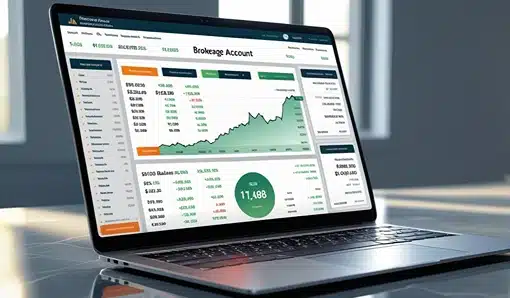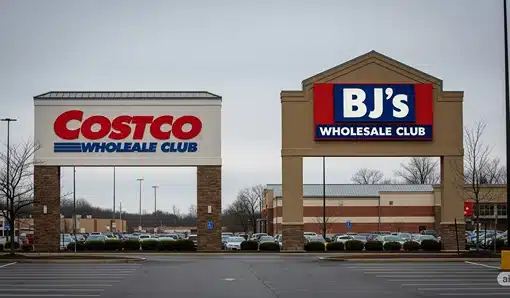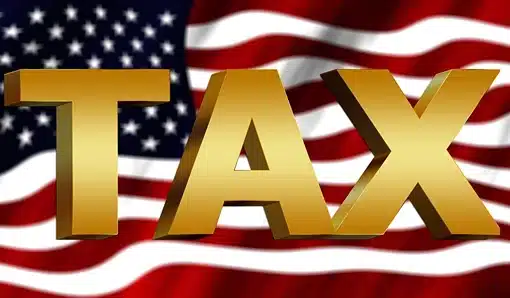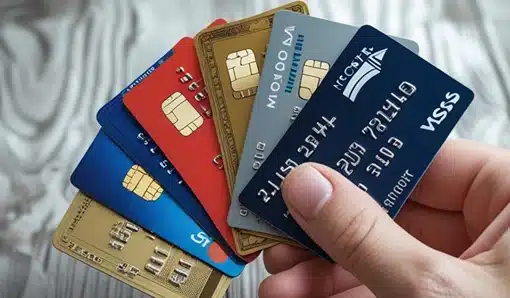Intro
If you’ve ever stared at a pile of bills and thought, “How will I ever get out of this?” — you’re not alone.
Debt can sneak into your life slowly until one day you realize it’s stealing your peace of mind and your paycheck.
The good news? Debt freedom isn’t just a dream. It’s absolutely doable — even on an average income.
This guide breaks down how to achieve debt freedom step-by-step, from cutting expenses, to re-structuring what you owe, to avoiding common traps.
We’ll talk strategy, motivation, and how becoming free from credit card debt can save the average family over $1,800/yr in interest fees.
Grab your favorite drink and settle in — by the end, you’ll have a clear plan (and a big dose of hope!)
Note: We use affiliate links to help cover site expenses. If you use these to shop and buy stuff, thanks in advance for your support!

The Case for Debt Freedom
When you’re in debt, you’re paying someone extra for the privilege of using their money.
It’s like having an extra tax on everything you buy, and no one wants more taxes.
Achieving debt freedom means you’ve taken back control — you’ve freed yourself from debt, and now your money serves you, not the other way around.
While debt sometimes has a place, the most important thing is to be fully aware of what it’s costing you to take it on.
Some debt like mortgage debt and student loan debt carry modest interest rates, but credit card debt is particularly insidious, so that’s what we’ll focus on in this article.
According to LendingTree, the average person with an unpaid credit card balance owes $7,300 with an interest rate close to 23% APR. While that 23% rate is crazy high, it gets worse.
Since credit card interest compounds daily, the true rate is even higher — close to 26%! That’s $1,868/year in interest fees vanishing from your pocket.
It’s important to stop that bleeding fast, and we’re here to help you do it!
Step by Step Guide to Debt Freedom
The secret to reaching debt freedom fast is structuring your debt like a pro, plugging the leaks where interest is bleeding you dry and turning the chaos into a battle plan.
To help, we’ve crafted a step-by-step guide to crush your debt and get you on the fast track to debt freedom.
Turning that overwhelming mess into a clear, actionable plan is totally within your reach, and we’re here to show you how.
Let’s begin!
1. Understand Your Existing Loans
The first place to start is to map out your existing loans — to fully understand what you’re facing so you can develop a plan to deal with it.
To do that, make a list of every loan type (e.g., credit card, car, home), balance you owe, interest rate, and minimum payment, and update it monthly.
This will become your debt payoff sheet. Be sure to put it somewhere visible as a daily reminder of the journey you’re on.
This will help you prioritize what you need to pay down first.
Plus, it helps motivate you when you start seeing those balances shrink!
Later on, we’ll talk more on how we’ll use that list, including different debt payoff methods, so stay tuned.
2. Reduce Your Spending to Pay Off Debt
Let’s tackle one of the toughest parts of being in debt: finding extra cash to actually pay it off.
You’re in the right spot, because Saving Your Tail is all about helping you outsmart your budget and win!
Check out our top articles to cut expenses for smart, practical tips to save big, fast — without having to sacrifice.
These free guides can put thousands back in your pocket each year, making debt repayment immensely easier.
Now, let’s pivot to the next strategy: lowering the interest rates on your loans.
Those high rates are like leeches, draining your wallet with every payment.
We’ll show you how to slow that bleed and fight your way out of the debt hole.
3. Ask for Lower Credit Card Interest Rates
Let’s focus on those credit card balances first.
Did you know that you may be able to get lower credit card interest rates simply by asking?
Sounds crazy, right?
Many aren’t aware of this, but many credit card issuers will offer lower rates or put you on a payment plan with lower rates, and all it takes is to ask.
For example, I was recently able to get an offer of 0% APR for 18 months on my existing Discover It card simply by asking customer support about special offers available.
We’ll talk more about how using 0% APR cards can help you get a handle on your debt further below.
4. Refinance Your Loans to Lower Interest Rates
Now, let’s switch gears to auto and home loans.
While you generally can’t just ask for lower auto or home rates and receive them, you do have the option of refinancing those types of loans.
Refinancing replaces an old loan with a new and better loan, resulting in lower monthly payments for you.
This is typically done by:
- Refinancing with a lower interest rate (e.g., going from 8% interest rate to 5%) or
- Refinancing with longer payoff (e.g., going from a 15-year loan to a 30-year loan)
The best way to do this is to check sites that compile loan offers from a large number of different lenders.
Here are a few examples of companies that offer that for mortgage refinances:
Be sure to indicate that you’re refinancing, as refinances carry different rates than new loans.
One caveat: refinancing requires paying fees, so be sure the rate difference is big enough to justify the fees, or they can totally eat up any advantage this gives you.
For example, if it’s only a 0.25% rate difference, refinancing may not save you enough money to be worth the effort.
Tip: Sometimes your existing lender will do a loan modification if you can prove financial hardship, letting you avoid refinance fees and the hassle of changing lenders.
5. Use Debt Consolidation to Combine Your Loans
The final tool for lowering your interest rates is debt consolidation.
When you’re drowning in multiple debts, combining several higher-interest loans into one new loan with a lower interest rate can really help.
Think of it like gathering all your noisy debt into one quiet room where you’re finally in charge.
Instead of juggling five due dates, five interest rates, and five stress headaches, you’ve got one payment and one clear plan.
Here are the 3 main ways to make it happen:
- Consolidate Debt With a Personal Loan
- Use a 0% Balance Transfer Credit Card
- Tap Your Home’s Equity for Lower Interest Rates
We’ll go into more detail on each of these in our debt consolidation section below.
6. Pick a Debt Payoff Method to Use
Now that you’ve done everything to lower the interest rates on your existing loans and slow the bleeding, it’s time to start paying them off.
A big success factor behind achieving debt freedom is having the motivation and persistence to make spending cuts and use them to pay down debt.
But psychology plays a big part here.
People are different, and different approaches work better for different personalities.
There are 2 popular debt payoff approaches that deserve consideration based on your personality type:
- Avalanche Method — paying off your highest interest loans first to minimize fees
- Snowball — paying off your smallest debts first for quick wins to build momentum
We’ll go into much more detail on these in our debt payoff section below.
7. Reward Small Wins
Finally, one of the biggest challenges people pursuing debt freedom face is failing to follow through to the end.
Celebrating progress along the way helps keep momentum alive!
One way you can do that is by promising yourself a reward at the end of the journey, or by creating milestones with smaller rewards along the way.
Now that we’ve covered the high level plan for getting to debt freedom, we’ll go into a few of these topics in greater detail below.

Using Debt Consolidation to Lower Interest Rates
Let’s dive further into one of the tools we mentioned above: debt consolidation.
Debt consolidation is a way to combine multiple debts into a single one with a lower interest rate.
We’ll walk through the 3 main methods you can use to make it happen in detail — and the pros and cons of each:
1. Consolidate Debt With a Personal Loan
The first way you can consolidate debt is with a personal loan.
You can take out a personal loan and use that money to pay off multiple high-interest balances (like credit cards or store cards) and replace them with one fixed-rate loan.
This makes it easy to see how much you owe, when you’ll be done paying, and what your interest rate is.
If your credit is solid, taking out a personal loan could drop a 23% APR credit card down to something closer to 10% or even single digits.
Pros:
- One predictable monthly payment
- Potentially much lower interest
- Clear payoff timeline
Cons:
- You’ll need decent credit to qualify for a good rate
- Some lenders charge origination fees
- If you start swiping your paid-off cards again, you’ll just double your debt load — so cut up, freeze, or hide them!
2. Avoid Interest With a 0% Balance Transfer Credit Card
Another debt consolidation option to consider, albeit a temporary one, is opening up a 0% balance transfer credit card.
These cards let you move multiple existing credit card balances onto a new card with a special introductory offer of 0% APR for 12–24 months.
It’s basically an interest-free window where every payment hits your principal instead of feeding the interest monster, allowing you to pay down the debt quicker.
But be aware – most cards charge a 3-5% balance transfer fee, so consider this a temporary measure at a cost, and be sure you have a solid plan to pay it off before the 0% offer period ends.
Also, this approach tends to work best for small debt balances, since the credit limit you’re approved for will determine how much you can transfer over.
Pros:
- 0% interest for a set time (usually 12–24 months)
- Simplifies multiple payments into one
- You avoid a lot of interest, allowing you to channel that toward paying off debt
Cons:
- There’s often a 3–5% fee on the balance being transferred
- If you don’t pay it off before the promo ends, your rate will return to 23%+
3. Tap Your Home's Equity for Lower Interest Rates
The final option for lowering interest rates is tapping into your home’s equity.
If you own your home, you may be able to borrow against your equity — often at much lower rates (think 6–8% instead of 20%+ on credit cards).
There are two options:
- A home equity loan gives you a lump sum with a fixed rate and payment schedule
- A HELOC (Home Equity Line of Credit) works more like a credit line you can draw from as needed.
But be very cautious — home equity is often our most hard earned asset, and taking out a loan against it can put it in jeopardy if you fail to make your payments.
Only proceed with this option if you have the utmost confidence in your repayment plan and are merely seeking the lowest rates possible as you head to the finish line.
Pros:
- Lower interest rates than unsecured loans
- Larger borrowing limits if you have significant equity
- Possible tax deductions (check with a tax pro)
Cons:
- You’re putting your home on the line — miss too many payments, and foreclosure becomes a risk
- Closing costs can be higher
- Easy to over-borrow if you’re not careful

Debt Payoff Methods: Avalanche and Snowball
When it comes to paying off debt, there’s no such thing as a one-size-fits-all strategy.
What works beautifully for one person might completely flop for another—and that’s okay.
The trick is finding a strategy that not only adds up financially but also keeps you motivated for the long haul.
Because, let’s face it, paying off debt is as much a mental and emotional marathon as it is a financial one.
Some people are fueled by quick wins and tangible progress, while others stay focused by maximizing savings on interest over time.
Here, we’ll explore two debt payoff methods that represent opposite ends of the spectrum — one optimized for saving the most money and the other designed to boost your psychological momentum.
Here’s where that debt payoff sheet we had you create earlier finally comes into play.
1. The Debt Avalanche Payoff Method
The debt avalanche method is a strategic approach that targets your debts with the highest interest rates first, prioritizing financial efficiency.
This method is the mathematical champion of debt repayment, designed to get you to debt freedom as quickly and cost-effectively as possible.
By focusing on high-interest debts first, you minimize the extra money sucked away by steep interest charges, keeping more cash in your pocket over time.
Think of it like plugging the biggest leaks in a sinking ship — tackling the costliest debts first ensures you’re not throwing money away on runaway interest.
How it works:
List all debts from highest to lowest interest rate.
Pay minimums on all but the one with the highest rate.
Put every extra dollar toward the highest-interest debt first.
Once that’s paid off, move to the next highest interest rate.
Pros:
Mathematically fastest payoff method.
Saves the most in total interest.
Cons:
May take longer to see progress (since large debts might be tackled first).
Harder to stay motivated if you need quick wins
2. The Debt Snowball Payoff Method
If you’ve ever stared down a pile of debt, you know it’s not just about crunching numbers — it’s about keeping your fire lit to actually get the job done.
That’s where the debt snowball method swoops in — this method is all about racking up quick wins by knocking out your smallest debts first, no matter the interest rate.
Those early victories hit like a burst of confetti, giving you a rush of progress that keeps your momentum roaring.
Every debt you wipe out is like crossing a finish line, pumping you up with that sweet dopamine hit to keep charging toward the ultimate goal: debt freedom.
The downside? Since you aren’t prioritizing paying down your highest interest rate loans first, you will end up paying more interest over time with this month.
But if you know yourself and think you’ll need that extra motivation boost to cross the finish line to debt freedom, this is the method for you!
How it works:
List debts from smallest to largest balance (ignore interest rate).
Pay minimums on all but the smallest debt.
Throw every extra dollar at the smallest debt until it’s gone.
Move to the next smallest, and so on.
Pros:
Builds motivation early as you see balances disappear.
Simple and easy to follow.
Cons:
Will cost more in interest overall.
Not the most efficient mathematically.
Now that you know the two most popular debt payoff methods, let’s switch gears to a more somber topic.
When It Gets Complicated — Debt Settlement and Bankruptcy
Sometimes, the situation becomes grim, and the math just stops working.
Maybe your debt has ballooned so much that paying it off would take decades — or you’re just barely keeping up with interest with no hope in sight, despite trying everything we’ve outlined above.
Whatever got you here doesn’t matter nearly as much as what you do next.
The good news? You still have options. And knowing what they are is the first step toward taking back control.
Before making any of the big decisions below, we recommend talking to a nonprofit credit counselor — it’s free and judgment-free.
The National Foundation for Credit Counseling can connect you with certified counselors who’ll walk you through options, from repayment plans to bankruptcy, and help you find the least damaging route forward.
That said, let’s highlight the options ahead, with the least damaging to your credit first:
1. Debt Settlement – Paying Less Than You Owe
Debt settlement means negotiating with your creditors to pay a lump sum that’s less than the total amount owed — typically through a debt settlement company or directly on your own.
Pros:
- You may settle debts for a fraction of what you owe
- Can help you avoid bankruptcy if handled carefully
Cons:
- Significant hit to your credit score for 7 years
- Forgiven debt might be considered taxable income
- Some creditors won’t negotiate, and there’s no guarantee of success
Sometimes the situation has become too grim for debt settlement to work — that’s where the dreaded “B” word comes in.
Let’s talk about bankruptcy options.
2. Chapter 13 Bankruptcy – The Wage Earner’s Plan
Chapter 13 is the bankruptcy option designed for people who still have steady income but need structure and protection to dig out.
You keep your property (home, car, etc.), but the court sets up a 3–5 year repayment plan that fits your income.
You’ll make one monthly payment to a trustee who distributes it to your creditors.
Pros:
- Stops foreclosure and repossession
- Lets you catch up on late mortgage or car payments
- You keep your assets while repaying what you can afford
Cons:
- Major hit to your credit score for 7 years
- Requires strict budgeting and on-time payments for several years
For those without a steady income, or those who are simply too deep into the whole climb out, let’s discuss Chapter 7 bankruptcy.
3. Chapter 7 Bankruptcy – A Fresh Start
When debt is overwhelming and there’s no feasible way to repay even part of it, Chapter 7 is the most common option individuals turn to.
It’s a liquidation process that wipes out most unsecured debts — like credit cards, medical bills, or personal loans.
A court-appointed trustee may sell any non-exempt assets to pay creditors, but most people keep essentials such as:
- A modest car
- Household items
- A certain amount of home equity (depending on state law)
The process usually wraps up in 3–6 months, giving you a clean slate much faster than Chapter 13.
Pros:
- Eliminates most unsecured debt
- Quick resolution and a true financial reset
Cons:
- Severe credit impact (stays on report up to 10 years)
- You could lose non-exempt property
- Some debts still not dischargeable (e.g., student loans, recent taxes)
Protecting Yourself From Debt Collectors
Finally, a brief word on debt collectors — if you fall significantly behind paying off a debt, you may be contacted by one.
Debt collectors are hired by the party you owe the debt to, and their job is to try to coerce you into paying them back quickly.
Dealing with debt collectors can feel intimidating, but be aware that you have rights.
Under the Fair Debt Collection Practices Act, debt collectors can’t call your family, freeze your bank account, put a lien on your home, or take your car without first obtaining a court order or judgment — unless it’s tied to the loan.
And if a debt collector violates the rules above, be aware that you are entitled to sue for emotional distress.
And when in doubt, check with a local attorney or legal aid office before paying any debt that you don’t recognize.

Frequently Asked Questions About Debt
A liquidated debt is a debt with a specific, agreed-upon amount that’s already known or easily calculated.
In other words, there’s no arguing over how much is owed — just when or how it’ll be paid.
Think of it like a set tab that’s ready to be paid, not one you’re still haggling over.
When a debt is discharged, it means you’re no longer legally required to pay it back.
This usually happens through bankruptcy — the court wipes out what you owe, giving you a clean slate.
It’s like hitting reset on that debt, though it can still leave a mark on your credit history.
Hiring an attorney for debt settlement can be a smart move if you’re dealing with large debts, aggressive collectors, or legal threats.
An attorney can negotiate on your behalf, make sure your rights are protected, and help you avoid scams.
But if your debt is smaller or straightforward, a reputable debt settlement company or even DIY negotiation might save you money.
If you marry someone with debt, that debt stays theirs — unless you co-sign, share accounts, or live in a community property state where certain debts can become shared.
But even if it’s not legally yours, their credit habits can still impact your financial life together.
It’s best to talk openly about money early on so you both start marriage on the same financial page.
Authorized users aren’t legally responsible for paying the credit card balance — that responsibility stays with the main account holder.
But their activity still shows up on their credit report, which can help or hurt their credit score depending on how the account is managed.
It’s a great credit-building tool if the primary user keeps payments on time and balances low.
If your spouse has died, you’re generally not personally responsible for their individual debts — unless you co-signed, shared a joint account, or live in a community property state where some debts are shared by law.
Their estate usually pays what’s owed before any inheritance is distributed.
Still, it’s smart to check your state laws and make sure collectors aren’t trying to pin something on you that isn’t yours.
Yes — credit card debt can be negotiated after death, but it’s handled through the person’s estate, not by family members.
The executor can often work with creditors to settle for less than the full balance using the estate’s funds.
Surviving relatives aren’t responsible for paying it — unless they were joint account holders, not just authorized users.
A power of attorney isn’t personally liable for someone’s debt.
Their job is just to manage money or decisions on that person’s behalf — not to take on their bills.
The only time they’d be responsible is if they mixed their own funds with the other person’s or signed something making themselves financially liable.
Yes — a car lease does count as debt, because it’s a financial obligation you’re committed to paying over time.
Even though you don’t own the car, lenders still see those monthly payments as part of your total debt load, which can affect your credit and debt-to-income ratio.
Yes — debt consolidation can affect buying a home, but not always in a bad way.
If it lowers your monthly payments and helps you manage debt better, it can actually boost your credit over time.
But if it temporarily drops your credit score or adds new credit inquiries, it could slow down mortgage approval in the short term.
Bottom Line
Debt freedom doesn’t happen overnight — it happens one intentional step at a time.
Whether you’re tackling high-interest balances with the avalanche method or building motivation with the snowball method, the key is consistency.
When you commit to paying off debt, you’re not just freeing up cash flow — you’re buying back peace of mind and taking ownership of your future.
If this guide helped you see a clearer path toward debt freedom, don’t stop here!
Pop your email into the orange subscribe box so you never miss the latest money-saving tips and debt payoff strategies.
And if you know someone who’s struggling with debt right now, share this post — you could be the person to help them reach debt freedom!
Savings from Eliminating Credit Card Debt
Here’s the math behind how much the average person could save in interest fees by eliminating their credit card debt.
Save:
- Avg monthly credit card balance carried in 2025: $7,300 per LendingTree
- Avg interest rate of 22.8% APR or 25.6% APY due to daily compounding interest
- $7,300 x 25.6% = $1,868/yr saved in interest fees by paying off credit card debt
Time Required:
- Varies widely, but assuming a person asks about lower interest rates and consolidates their debt to pay off credit card debt, we’ll estimate:
- +5 hrs
Results:
- $1,868/yr saved
- $1868 saved / 5 hrs
- =$374/hr savings rate






One response to “How to Achieve Debt Freedom: A Step by Step Guide”
10-26-2025
SYT,
Thank you for the insightful article. Your work is much appreciated.